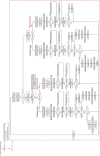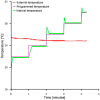A Low-Cost Chamber Prototype for Automatic Thermal Analysis of MEMS IMU Sensors in Tilt Measurements Perspective
- PMID: 31208118
- PMCID: PMC6631763
- DOI: 10.3390/s19122705
A Low-Cost Chamber Prototype for Automatic Thermal Analysis of MEMS IMU Sensors in Tilt Measurements Perspective
Abstract
In this work, a low-cost, open-source and replicable system prototype for thermal analysis of low-cost Micro Electro-Mechanical Systems (MEMS) Inertial Measurement Unit (IMU) sensors in tilt measurement perspective is presented and tested. The system is formed of a 3D printed frame, a thermal cell consisting in a Peltier element mounted over a heat sink, and a control and power system. The frame is designed to allow the independent biaxial tilting of the thermal cell through two servomotors. The control board is formed by an Arduino® and a self-made board including a power drive for controlling the thermal unit and servomotors. We tested the chamber analyzing the behavior of multiple MEMS IMU onboard accelerometers suitable for measuring tilt. Our results underline the variability of the thermal behavior of the sensors, also for different sensor boards of the same model, and consequently the need for the adoption of a thermal compensation strategy based on thermal analysis results. These data suggesting the need for the analysis of the thermal behavior of MEMS-based sensors, indicate the potential of our system in making low-cost sensors suitable in medium-to-high precision monitoring applications.
Keywords: Arduino®; Micro Electro-Mechanical Systems (MEMS); Peltier; accelerometer; thermal chamber; tilt.
Conflict of interest statement
The authors declare no conflict of interest.
Figures











Similar articles
-
Thermal Compensation of Low-Cost MEMS Accelerometers for Tilt Measurements.Sensors (Basel). 2018 Aug 2;18(8):2536. doi: 10.3390/s18082536. Sensors (Basel). 2018. PMID: 30072680 Free PMC article.
-
Error and Performance Analysis of MEMS-based Inertial Sensors with a Low-cost GPS Receiver.Sensors (Basel). 2008 Mar 29;8(4):2240-2261. doi: 10.3390/s8042240. Sensors (Basel). 2008. PMID: 27879820 Free PMC article.
-
Performance Enhancement of Consumer-Grade MEMS Sensors through Geometrical Redundancy.Sensors (Basel). 2021 Jul 16;21(14):4851. doi: 10.3390/s21144851. Sensors (Basel). 2021. PMID: 34300592 Free PMC article.
-
Random Error Reduction Algorithms for MEMS Inertial Sensor Accuracy Improvement-A Review.Micromachines (Basel). 2020 Nov 21;11(11):1021. doi: 10.3390/mi11111021. Micromachines (Basel). 2020. PMID: 33233457 Free PMC article. Review.
-
Micromachined Fluid Inertial Sensors.Sensors (Basel). 2017 Feb 14;17(2):367. doi: 10.3390/s17020367. Sensors (Basel). 2017. PMID: 28216569 Free PMC article. Review.
Cited by
-
3D-Printed MEMS in Italy.Micromachines (Basel). 2024 May 22;15(6):678. doi: 10.3390/mi15060678. Micromachines (Basel). 2024. PMID: 38930648 Free PMC article. Review.
-
Self-Calibration Technique with Lightweight Algorithm for Thermal Drift Compensation in MEMS Accelerometers.Micromachines (Basel). 2022 Apr 8;13(4):584. doi: 10.3390/mi13040584. Micromachines (Basel). 2022. PMID: 35457889 Free PMC article.
-
A Multi-Module Fixed Inclinometer for Continuous Monitoring of Landslides: Design, Development, and Laboratory Testing.Sensors (Basel). 2020 Jun 10;20(11):3318. doi: 10.3390/s20113318. Sensors (Basel). 2020. PMID: 32532152 Free PMC article.
-
Lightweight Thermal Compensation Technique for MEMS Capacitive Accelerometer Oriented to Quasi-Static Measurements.Sensors (Basel). 2021 Apr 30;21(9):3117. doi: 10.3390/s21093117. Sensors (Basel). 2021. PMID: 33946219 Free PMC article.
-
A Low-Cost Lightweight Deflectometer with an Arduino-Based Signal Interpretation Kit to Evaluate Soil Modulus.Sensors (Basel). 2023 Dec 8;23(24):9710. doi: 10.3390/s23249710. Sensors (Basel). 2023. PMID: 38139556 Free PMC article.
References
-
- Daponte P., de Vito L., Picariello F., Riccio M. State of the art and future developments of measurement applications on smartphones. Measurement. 2013;46:3291–3307. doi: 10.1016/j.measurement.2013.05.006. - DOI
-
- Li C., Fernandez-Streeger T.M., Link J.A.B., May M., Azzam R. Use of Mems Accelerometers as a Getechnical Monitoring Method for Ground Subsidence. Acta Geodyn. Geomater. 2014;11:337–349. doi: 10.13168/AGG.2014.0015. - DOI
-
- Milne D., le Pen L., Watson G., Thompson D., Powrie W., Hayward M., Morley S. Proving MEMS Technologies for Smarter Railway Infrastructure. Procedia Eng. 2016;143:1077–1084. doi: 10.1016/j.proeng.2016.06.222. - DOI
LinkOut - more resources
Full Text Sources

